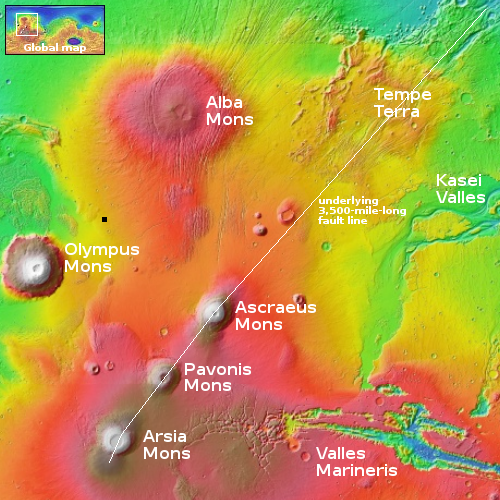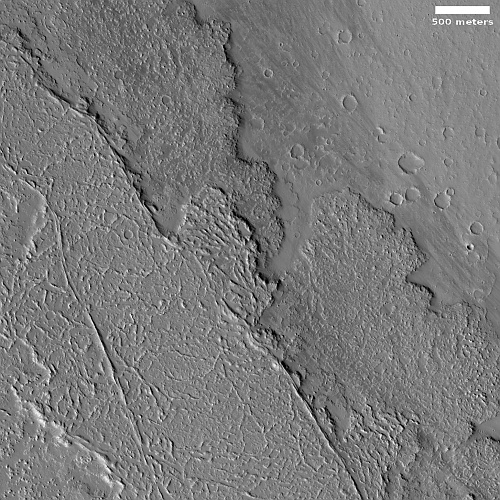Where the flood lava of two gigantic Martian volcanoes meet
Today’s cool image illustrates once again the importance of looking not simply at the picture but at the surrounding larger context in order to understand the Martian features within the photograph.
The photo to the left, cropped, reduced, and sharpened to post here, was taken on January 31, 2023 by the high resolution camera on Mars Reconnaissance Orbiter (MRO). The location is at 26 north latitude, so it is in the dry equatorial regions. It shows what appears to be a large Martian flood lava plain, with at least two different flood lava events appearing to flow to the northeast, with the second only partly covering the first.
From this high resolution image it seemed probable that the source of the flow was from the southwest, an assumption that at first glance is strengthened by the overview map below.


The black dot between the volcanoes Olympus Mons and Alba Mons marks this location. Since the lava is closer to Olympus Mons and appears to descend to the northeast, assuming this flood lava came from Olympus seems reasonable.
And that assumption is wrong. The second image to the right was taken on January 9, 2012 by MRO’s context camera. The white rectangle indicates the area covered by the high resolution image above.
The context image clearly shows that the first picture is showing the northern edge of a tongue of lava flowing down from the east. Instead of coming from Olympus Mons, this flood lava was probably released by the giant but relatively flat shield volcano Alba Mons, even though the indistinct caldera of Alba is twice as far away, a distance of about 1,200 miles.
Can lava on Mars flow so far before hardening? Apparently it can, according other research. The low Martian gravity makes lava on Mars is less viscous than on Earth, so it flows much faster. For example, scientists believe that a lava flow in Kasei Valles traveled more than 1,000 miles in less than a few weeks.
In this case it appears the flows from Alba Mons were covering the earlier flows from Olympus Mons, suggesting that the former is younger than the latter. We don’t know this yet, but this is what this data suggests.
These volcano images also illustrate the importance on any issue of always digging a bit more before forming any opinion. I could have simply looked at the high resolution image above and concluded it came from Olympus Mons, but I decided I needed to look a little deeper. Similarly, when I write my daily blacklist column I always dig a bit deeper, reading not just the original story but the legal documents as well as other news reports. I also often review the websites of the individuals and institutions involved to find out more about them.
In our quick-click internet social media world today, people tend to read a short article quickly and instantly form an opinion. Similarly, many journalists read a press release and do little other research, essentially regurgitating what they have read. This is all a mistake, as almost certainly these instantaneous conclusions are in error, or lacking in depth. Our society would become far more civilized and thoughtful if everyone always took a breath and looked deeper.
On Christmas Eve 1968 three Americans became the first humans to visit another world. What they did to celebrate was unexpected and profound, and will be remembered throughout all human history. Genesis: the Story of Apollo 8, Robert Zimmerman's classic history of humanity's first journey to another world, tells that story, and it is now available as both an ebook and an audiobook, both with a foreword by Valerie Anders and a new introduction by Robert Zimmerman.
The print edition can be purchased at Amazon or from any other book seller. If you want an autographed copy the price is $60 for the hardback and $45 for the paperback, plus $8 shipping for each. Go here for purchasing details. The ebook is available everywhere for $5.99 (before discount) at amazon, or direct from my ebook publisher, ebookit. If you buy it from ebookit you don't support the big tech companies and the author gets a bigger cut much sooner.
The audiobook is also available at all these vendors, and is also free with a 30-day trial membership to Audible.
"Not simply about one mission, [Genesis] is also the history of America's quest for the moon... Zimmerman has done a masterful job of tying disparate events together into a solid account of one of America's greatest human triumphs."--San Antonio Express-News
Today’s cool image illustrates once again the importance of looking not simply at the picture but at the surrounding larger context in order to understand the Martian features within the photograph.
The photo to the left, cropped, reduced, and sharpened to post here, was taken on January 31, 2023 by the high resolution camera on Mars Reconnaissance Orbiter (MRO). The location is at 26 north latitude, so it is in the dry equatorial regions. It shows what appears to be a large Martian flood lava plain, with at least two different flood lava events appearing to flow to the northeast, with the second only partly covering the first.
From this high resolution image it seemed probable that the source of the flow was from the southwest, an assumption that at first glance is strengthened by the overview map below.


The black dot between the volcanoes Olympus Mons and Alba Mons marks this location. Since the lava is closer to Olympus Mons and appears to descend to the northeast, assuming this flood lava came from Olympus seems reasonable.
And that assumption is wrong. The second image to the right was taken on January 9, 2012 by MRO’s context camera. The white rectangle indicates the area covered by the high resolution image above.
The context image clearly shows that the first picture is showing the northern edge of a tongue of lava flowing down from the east. Instead of coming from Olympus Mons, this flood lava was probably released by the giant but relatively flat shield volcano Alba Mons, even though the indistinct caldera of Alba is twice as far away, a distance of about 1,200 miles.
Can lava on Mars flow so far before hardening? Apparently it can, according other research. The low Martian gravity makes lava on Mars is less viscous than on Earth, so it flows much faster. For example, scientists believe that a lava flow in Kasei Valles traveled more than 1,000 miles in less than a few weeks.
In this case it appears the flows from Alba Mons were covering the earlier flows from Olympus Mons, suggesting that the former is younger than the latter. We don’t know this yet, but this is what this data suggests.
These volcano images also illustrate the importance on any issue of always digging a bit more before forming any opinion. I could have simply looked at the high resolution image above and concluded it came from Olympus Mons, but I decided I needed to look a little deeper. Similarly, when I write my daily blacklist column I always dig a bit deeper, reading not just the original story but the legal documents as well as other news reports. I also often review the websites of the individuals and institutions involved to find out more about them.
In our quick-click internet social media world today, people tend to read a short article quickly and instantly form an opinion. Similarly, many journalists read a press release and do little other research, essentially regurgitating what they have read. This is all a mistake, as almost certainly these instantaneous conclusions are in error, or lacking in depth. Our society would become far more civilized and thoughtful if everyone always took a breath and looked deeper.
On Christmas Eve 1968 three Americans became the first humans to visit another world. What they did to celebrate was unexpected and profound, and will be remembered throughout all human history. Genesis: the Story of Apollo 8, Robert Zimmerman's classic history of humanity's first journey to another world, tells that story, and it is now available as both an ebook and an audiobook, both with a foreword by Valerie Anders and a new introduction by Robert Zimmerman.
The print edition can be purchased at Amazon or from any other book seller. If you want an autographed copy the price is $60 for the hardback and $45 for the paperback, plus $8 shipping for each. Go here for purchasing details. The ebook is available everywhere for $5.99 (before discount) at amazon, or direct from my ebook publisher, ebookit. If you buy it from ebookit you don't support the big tech companies and the author gets a bigger cut much sooner.
The audiobook is also available at all these vendors, and is also free with a 30-day trial membership to Audible.
"Not simply about one mission, [Genesis] is also the history of America's quest for the moon... Zimmerman has done a masterful job of tying disparate events together into a solid account of one of America's greatest human triumphs."--San Antonio Express-News


